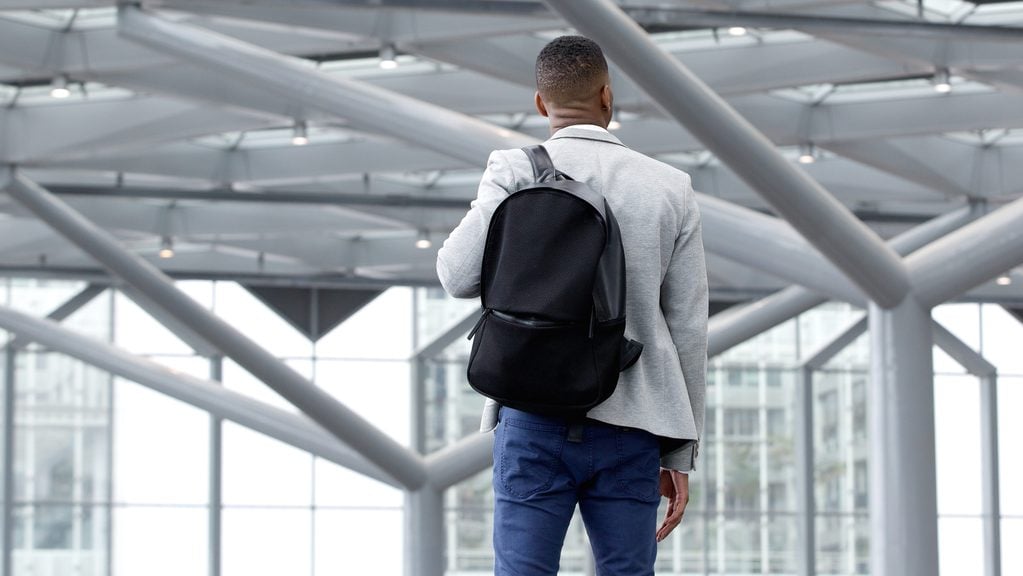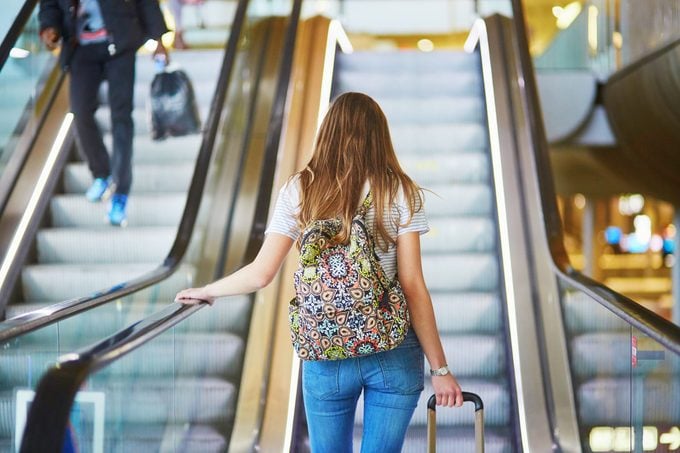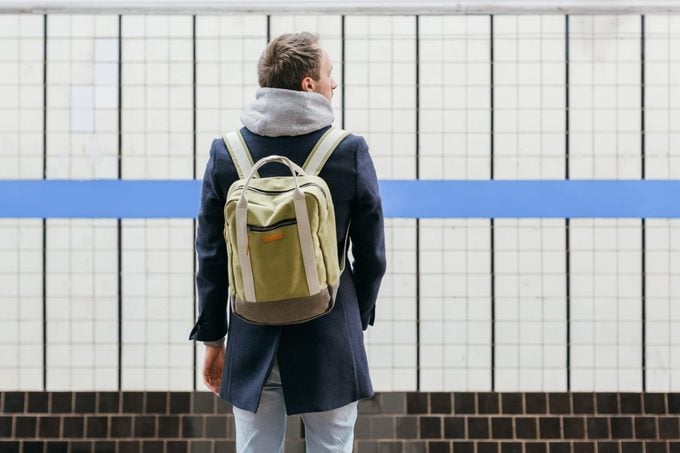What Happens to Your Body When You Wear a Heavy Backpack Every Day
Updated: Nov. 07, 2022

Toting around all of your stuff doesn't have to cause back pain. Learn how your backpack is affecting you—and what to do about it.
When you first get a backpack, you put in just what you need. It’s perfectly filled and perfectly comfortable. But as time goes on, it tends to get packed with more and more stuff, and your back starts to hurt. Since the shift is gradual, you might not even realize it at first, but it can turn into a big problem. Here’s how to figure out if your backpack is too heavy.
Around 80 percent of adults experience lower back pain at some point in their lives, and lifting or carrying heavy items can contribute to this problem. And while it seems like the norm for kids to have a backpack brimming with textbooks and supplies, it’s not a good idea. According to a study published in PLOS One in 2018, carrying a backpack weighing more than 10 percent of a child’s body weight is linked to back and neck pain.
You might be shocked to learn how backpacks can negatively affect your body, but we also have some good news: Just a few easy, expert-approved adjustments can keep your back—and your kids’ backs—safe.
Your posture changes
You probably don’t realize just how much a heavy backpack affects your posture. But you can check it out for yourself: Stand normally without a backpack, and then hoist a filled-to-the-brim one over your shoulders and see how your entire body shifts. You can also see this effect in children, where it may be even more dramatic. “A telltale sign of a too-heavy backpack is when it pulls the child backward, causing them to lean forward at the hips or arch the back,” says Neel Anand, MD, professor of orthopedic surgery and director of spine trauma at Cedars-Sinai Spine Center in Los Angeles. “This results in an unnatural compression of the spine and reduces balance, making it easier to fall and get hurt.”
Your spine’s alignment suffers
As you lean forward to compensate for a heavy backpack, that altered posture can lead to alignment issues in your spine. “In the long term, wearing a heavy backpack every day can cause misalignment of the spine and acceleration of the degenerative process of normal aging of the spine,” says board-certified physical medicine and rehabilitation physician D’Wan Carpenter, DO. “The muscles can become subjected to overuse, which can, in turn, become more subjected to injury.” While you’re taking a closer look at your backpack, here’s what the real purpose behind those diamond-shaped patches on backpacks is.
You’re at a higher risk for arthritis
The wear and tear caused by a heavy backpack can go way beyond temporary back pain. “The additional weight [of the backpack] then becomes transmitted through the joints of the spine, the hips, and the knees,” says Dr. Carpenter. “This can increase the risk of premature osteoarthritis (the wear and tear of joints).”

Your core muscles weaken
When a heavy backpack causes you to lean forward, you can start losing strength in your abs and back. “Excessive forward leaning can also result in too much stress on your lower back, much like repetitively bending forward can,” says Rhode Island-based physical therapist Kendra Kohanski. “Over time, your back and core muscles can actually weaken, which may result in back pain.”
You could experience headaches
A heavy backpack, especially when worn too low on the body, can start to pull on overworked neck muscles and subsequently cause headaches. “Backpacks can do more than injure your back; they also frequently affect the neck and shoulders,” says David Nelles, MD, an orthopedic spine surgeon in California.
If you have been experiencing daily headaches or numbness and tingling, try taking a break from your backpack. “Long -term use can compress cervical nerves, leading to numbness, tingling, and radiating pain at the neck and down the arms,” says physical therapist and yoga instructor Lara Heimann. “A heavy backpack can contribute to headaches and chronic neck discomfort because of the increased posterior load.”
Considerations for young children
As your child’s spine grows and changes, it is essential to protect it. “The adolescent spine is composed of 33 vertebrae bones with discs that serve as shock absorbers,” explains Nabil Ebraheim, MD, chair of the Department of Orthopaedic Surgery at the University of Toledo College of Medicine and Life Sciences.
While wearing a heavy backpack can be problematic for both adults and kids, children are especially at risk. “Kids have less awareness and coordination, which means it is a lot easier for them to fall into ‘bad’ postural habits,” explains Kohanski. “Educate them on how to stand, walk, and use backpacks appropriately.” But which type of bag is safest?
Check your backpack’s weight
After reading all of that, you might be ready to burn every backpack in your house. But, well, don’t. There are a few key actions you can take to make wearing a backpack safer. The first one is the easiest and most logical: Make sure your backpack isn’t too heavy. For kids, avoid overstuffing the backpack, and limit the weight to 10 to 15 percent of the child’s body weight, advises Dr. Ebraheim. “Carrying a backpack that weighs more than this is too heavy to maintain normal standing posture, causing the child to then lean forward and affect the natural curve in the spine in the lower back,” he adds. “This can contribute to multiple orthopedic problems.”
How to wear your backpack
Once you’ve determined that a backpack is a safe weight, check the fit. “It is not only important to pick a proper backpack—you must also wear it correctly to get the full benefits,” explains Dr. Nelles. Once you or your child are wearing the backpack, tighten the straps to make sure the backpack isn’t sagging and pulling on those sensitive back muscles.
Also, try to wear your backpack as infrequently as possible. Children, for example, should be encouraged to use their locker instead of carrying around the entire day’s worth of books in a backpack, says Dr. Nelles.

Find the right backpack for you
The right backpack can make a big difference. And while different people will like different backpacks, there are a few general rules of thumb that you should keep in mind.
“Look for backpacks with lots of inside pockets so the weight inside the bag can be more evenly distributed,” says New York City-based physical therapist Karena Wu. Next, check out the straps. “Look for ones that are wide, contoured to the body and well ventilated,” she adds. “Additional waist straps are great, too, because that can help disperse the load.” Also make sure that the straps and the back of the backpack have supportive padding.
Dr. Carpenter agrees. “I actually own one similar to this [Swiss gear Synergy Pro Laptop Backpack],” she shares.
Special considerations for your lifestyle
If you’re an outdoor adventurer, you won’t want to miss Heimann’s recommendation. “I love Osprey backpacks, as I have used them for many backpacking adventures where I carried heavy loads with no back pain,” she says. “Their backpacks can be used as a day pack, as a rigorous backpack, or as a school backpack.”
To avoid carrying a heavy load on your back, you also might want to consider a rolling backpack. “Backpacks on wheels and rolling laptop bags are more common in schools and are sometimes good options for students,” explains Dr. Anand. Just make sure not to overload them so that they’re not too heavy to carry up stairs.
In your quest to find the perfect backpack, it’s a good idea to test out a few before making a decision. It may take some trial and error, but it’s well worth it—and your back will thank you.
Sources:
- National Institute of Neurological Disorders and Stroke: “Low Back Pain Fact Sheet”
- PLOS ONE: “Effects of backpack load and position on body strains in male schoolchildren while walking”
- Neel Anand, MD, professor of orthopaedic surgery and director of spine trauma at Cedars-Sinai Spine Center in Los Angeles
- Board-certified Physical Medicine and Rehabilitation physician D’Wan Carpenter, DO
- Physical therapist Kendra Kohanski, DPT
- Orthopedic spine surgeon David Nelles, MD
- Physical therapist and yoga instructor Lara Heimann
- Nabil Ebraheim, MD, professor and chair of the Department of Orthopaedic Surgery at the University of Toledo College of Medicine and Life Sciences
- New York City–based physical therapist Karena Wu
